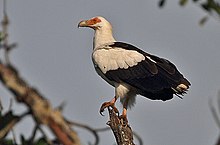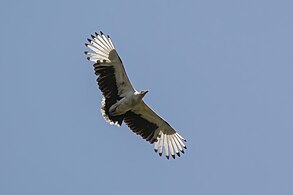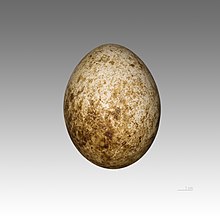Palm-nut vulture
| Palm-nut vulture | |
|---|---|

| |
| Scientific classification | |
| Kingdom: | Animalia |
| Phylum: | Chordata |
| Class: | Aves |
| Order: | Accipitriformes |
| Family: | Accipitridae |
| Genus: | Gypohierax Rüppell, 1836 |
| Species: | G. angolensis
|
| Binomial name | |
| Gypohierax angolensis (Gmelin, 1788)
| |
The palm-nut vulture (Gypohierax angolensis) or vulturine fish eagle, is a large bird of prey in the family Accipitridae (which also includes many other diurnal raptors such as kites, buzzards and harriers, vultures, and eagles). It is the only member of the genus Gypohierax.
This bird is an Old World vulture (only distantly related to the New World vultures, which are in a separate family, the Cathartidae).
It breeds in forest and savannah across sub-Saharan Africa, usually near water, its range coinciding with that of the oil and Raffia palms. It is quite approachable, like many African vultures, and can be seen near habitation, even on large hotel lawns in the tourist areas of countries such as the Gambia.
Description[]
This is a nearly unmistakable bird as an adult. At 1.3–1.7 kg (2.9–3.7 lb), 60 cm (2.0 ft) long and 150 cm (4.9 ft) across the wings, this is the smallest Old World vulture.[2][3] Its plumage is all white except for black areas in its wings and tail. It has a red patch around each eye. The juvenile, which takes 3–4 years to mature, is brown with yellow eye-patches. In flight, this species resembles an eagle more than a typical vulture, and it can sustain flapping flight, so it does not depend on thermals. With its extensive white plumage, and black wing- and tail-feathers, the adult palm-nut vulture can be crudely mistaken for both the African fish-eagle and the Egyptian vulture, but clearly lacks the chestnut body of the former and the white tail of the latter[4][failed verification]
The sexes are identical in appearance, with the female being the same size as the male. Juveniles on the other hand are predominately brown with partially black wings and take a lengthy three to four years to make the transition into the adult plumage[5]

Immature bird in Selous Game Reserve, Tanzania

Adult in flight in Semliki Wildlife Reserve, Uganda

Adult on nest at Kazinga Channel, Uganda
Distribution and density[]
Palm-nut vultures are found throughout most of the coastal areas of the African continent from The Gambia to Kenya and as far South as South Africa.[5] The total African population is estimated to be 80 000 pairs.[6] There are approximately 40 birds in South Africa.
In South Africa[]
The only Southern African subregions to have resident breeding pairs of Palm-nut vultures are South Africa and Mozambique. The breeding distribution of the Palm-nut Vulture during the 1970s census period was centred on the Raffia Palm groves of the Kosi Bay system and Mtunzini. Its distribution is linked to the presence of the Raffia palm Raphia australis at all permanently occupied sites, and the existence of this species at Mtunzini is entirely due to the artificial cultivation of Raffia palms.[7] Currently there are 7 known nesting sites in South Africa and a total of 40 individual birds.
Habitat[]
As the name suggests, the distribution of the palm-nut vulture closely tracks that of oil (Elaeis guineensis) or raffia (Raphia sp.) palms. Consequently, it is most common in coastal forests and mangrove swamps below 1,500 m (4,900 ft), but also occurs in wet savannas.[5]
Diet and feeding habits[]
Unusually for birds of prey, the palm-nut vulture feeds mainly on the fleshy fruit-husks of the oil palm and on the palm-fruits of Raffia palm. These fruits make up over 60% of the adult bird's diet and over 90% of the juvenile bird's diet.[5] It has also been recorded to feed on crabs (both freshwater and marine), molluscs, frogs, fish, locusts, small mammals, even reptiles’ eggs and hatchlings, and it has been known to occasionally attack domestic poultry and feed on carrion.[8][9][10][11]
Nesting[]

Breeding pairs construct large stick nests high up in tall trees and will often exhibit a strong attachment to the nest site. They may stay at the nesting site for an entire year. Where Raphia Palms are present, breeding pairs will build a nest at the base of the palm fronds. At the beginning of the breeding season, pairs soar together in an aerial display of rolling and diving, much more acrobatic than most vultures. During each breeding cycle, a single, white and brown egg is laid, which is incubated by both sexes, over a period of four to six weeks. Normally around 85 to 90 days after hatching, the young brown chicks will fledge.[5]
Current threats and conservation efforts[]
This species is widespread throughout much of Africa, overall fairly common and with a stable population.[1] It is rarer and much more localized in South Africa, although not considered to be under any form of immediate threat in that country.[12] That being said, the threats to this species in South Africa are not well understood. The low population size makes the species vulnerable to stochastic events. In Mozambique Parker (1999)[13] observed that cutting down of coastal forest was threatening breeding habitat. The main threat to this species in South Africa is habitat loss. Open cast sand dune mining and urban expansion have reduced suitable habitats.
The cultivation of Raphia palms for its ornamental value is currently increasing providing food and nesting sites. There is also a large portion of its habitat protected by the Isimangaliso Wetland Park. There are no current species specific conservation initiatives as this species is the only vulture species in South Africa where the population size is increasing. The importance of maintaining this is that the South African satellite population in producing dispersing birds that are contributing to maintaining the Mozambique population (and hence the larger metapopulation).
References[]
- ^ a b BirdLife International 2016. Gypohierax angolensis (errata version published in 2019). The IUCN Red List of Threatened Species 2016: e.T22695170A157472666. https://dx.doi.org/10.2305/IUCN.UK.2016-3.RLTS.T22695170A157472666.en. Downloaded on 22 April 2020.
- ^ "Palm-nut vulture videos, photos and facts — Gypohierax angolensis". ARKive. Archived from the original on 2011-06-28. Retrieved 2011-05-29.
- ^ "Palm-nut Vulture — Gypohierax angolensis". oiseaux-birds.com. Retrieved 2011-05-29.
- ^ Pawson, Lara (October 1994). "Stuart Mclean, South African Golf Courses: a portrait of the best. Cape Town: Struik Publishers, 1993, 144 pp., £29.99, ISBN 1 86825 338 4". Africa. 64 (4): 603. doi:10.2307/1161396. ISSN 0001-9720. JSTOR 1161396.
- ^ a b c d e van Zyl, Anthony (November 2006). "Raptors of the world: a field guide by James Ferguson-Lees and David Christie". Ostrich. 77 (3–4): 235–236. doi:10.2989/00306520609485540. ISSN 0030-6525.
- ^ HOLT, P. (February 1994). MUNDY, P., BUTCHART, D., LEDGER, J. and PIPER, S.The vultures of Africa. Academic Press, London: 1992 (originally published by Acorn Books, Johannesburg: 1992). Pp 460; illustrated. Price: £55.00. Archives of Natural History. 21. p. 136. doi:10.3366/anh.1994.21.1.136. ISBN 978-0-12-510585-9. ISSN 0260-9541.
- ^ Gidlow, R.M. (September 2002). "The history of exchange controls in South Africa". South African Journal of Economic History. 17 (1–2): 25–48. doi:10.1080/10113430209511143. ISSN 1011-3436. S2CID 153424887.
- ^ Mikula, P.; Morelli, F.; Lučan, R. K.; Jones, D. N.; Tryjanowski, P. (2016). "Bats as prey of diurnal birds: a global perspective". Mammal Review. 46 (3): 160–174. doi:10.1111/mam.12060.
- ^ Carneiro, Camilo; Henriques, Mohamed; Barbosa, Castro; Tchantchalam, Quintino; Regalla, Aissa; Patrício, Ana R.; Catry, Paulo (2017-04-10). "Ecology and behaviour of Palm-nut Vultures Gypohierax angolensis in the Bijagós Archipelago, Guinea-Bissau". Ostrich. 88 (2): 113–121. doi:10.2989/00306525.2017.1291540. ISSN 0030-6525. S2CID 90586336.
- ^ HOLT, P. (February 1994). MUNDY, P., BUTCHART, D., LEDGER, J. and PIPER, S.The vultures of Africa. Academic Press, London: 1992 (originally published by Acorn Books, Johannesburg: 1992). Pp 460; illustrated. Price: £55.00. Archives of Natural History. 21. p. 136. doi:10.3366/anh.1994.21.1.136. ISBN 978-0-12-510585-9. ISSN 0260-9541.
- ^ "Vultures". The Birds of Africa. Academic Press Limited. 1982. doi:10.5040/9781472926982.part-0185. ISBN 9780121373016.
- ^ Lattke, Michael (2005-05-10). "Vorwort". Oden Salomos. Teil 3. pp. VII–VIII. doi:10.13109/9783666539572.vii. ISBN 978-3-525-53957-6.
- ^ Lamm, Donald W. (May 1953). "Comments on Certain Records from Northern Sul do Save, Mozambique". Ostrich. 24 (1): 2–8. doi:10.1080/00306525.1953.9632608. ISSN 0030-6525.
Further reading[]
- BirdLife International (2016). "Gypohierax angolensis". IUCN Red List of Threatened Species. 2016: e.T22695170A157472666. doi:10.2305/IUCN.UK.2016-3.RLTS.T22695170A157472666.en. Retrieved 12 November 2021.
- Thomson, A. L.; Moreau, R. E. (1957). "Feeding Habits of the Palm-Nut Vulture Gypohierax". Ibis. 99 (4): 608–613. doi:10.1111/j.1474-919X.1957.tb03053.x.
External links[]
- Palmnut Vulture - Species text in The Atlas of Southern African Birds.
| Wikimedia Commons has media related to Gypohierax angolensis. |
| Wikispecies has information related to Gypohierax angolensis. |
- IUCN Red List least concern species
- Accipitridae
- Old World vultures
- Birds of the Gulf of Guinea
- Birds of prey of Sub-Saharan Africa
- Birds described in 1788
- Taxa named by Johann Friedrich Gmelin



